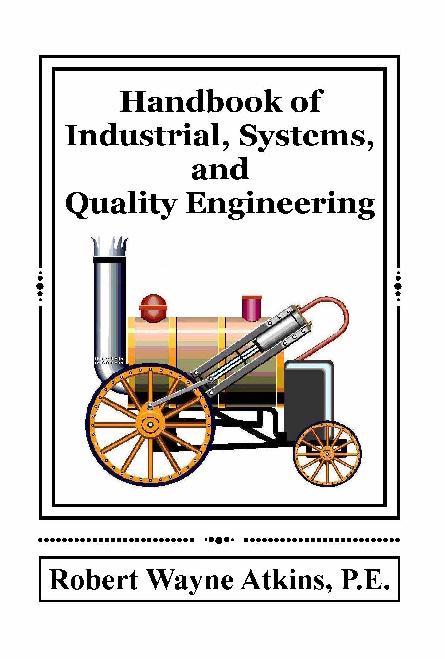| Chapter | | Page |
| Section One: Introduction | |
| 1 | Academic Approach versus a Practical Approach | 1 |
| 2 | Computer Hardware and Computer Software | 5 |
| 3 | History of Industrial, Systems, and Quality Engineering | 9 |
| 4 | Safety | 15 |
| Section Two: Charting Techniques | |
| 5 | Charting Symbols | 19 |
| 6 | Operation Process Charts | 23 |
| 7 | Flow Process Charts and Flow Diagrams | 27 |
| 8 | Left Hand - Right Hand Charts | 37 |
| 9 | Multiple Activity Charts | 41 |
| 10 | Histograms, Frequency Distributions, Bar Charts | 45 |
| 11 | Scatter Diagrams | 49 |
| 12 | Affinity, Structure Tree, and Force Field Diagrams | 53 |
| Section Three: Probability and Statistics | |
| 13 | Basic Math, Algebra, Geometry, Trigonometry | 57 |
| 14 | Probability Theory | 65 |
| 15 | Basic Statistics: Averages, Variability, and Proportions | 71 |
| 16 | Discrete Distributions: Hypergeometric, Binomial, Poisson | 77 |
| 17 | Continuous Distributions: Normal, Exponential, Weibull | 87 |
| 18 | Minimum Sample Size | 103
|
| 19 | Simple Linear Regression | 107 |
| 20 | Reliability | 117 |
| 21 | Queuing Theory | 131 |
| Section Four: Quality Theory and Practice | |
| 22 | A Brief History of the Evolution of Quality Theories | 139 |
| 23 | Quality Standards and Continuous Improvement | 143 |
| 24 | Quality Acceptance Sampling Plans | 147 |
| 25 | Quality Control Charts | 167 |
| 26 | Lean Six Sigma, 7 QC Tools, SPC, Root Cause Analysis | 197 |
| Section Five: Metrology, Calibration, and Gage Studies | |
| 27 | Metrology: The Science of Measurements | 207 |
| 28 | Standards and Procedures | 213 |
| 29 | Basic Calibration Concepts | 223 |
| 30 | Gage Studies: Repeatability and Reproducibility | 239 |
| Section Six: Job Analysis | |
| 31 | Job Analysis and Data Collection Techniques | 255 |
| 32 | Learning Curves | 263 |
| Section Seven: Human Factors and Ergonomics | |
| 33 | Anthropology and Anthropometry | 279 |
| 34 | Human Factors Engineering and Ergonomics | 281 |
| 35 | Motion Study and Therbligs | 285 |
| 36 | Motion Economy Principles | 289 |
| Section Eight: Work Measurement | |
| 37 | The History and the Future of Work Measurement | 299 |
| 38 | Element Analysis | 301 |
| 39 | Personal, Fatigue, and Delay Allowances | 305 |
| 40 | Work Measurement and Engineered Standards | 319 |
| 41 | Performance Rating, Pace/Speed Rating Systems | 329 |
| 42 | The Best Pace/Speed Rating System & 100% Performance | 343 |
| 43 | Time Study | 357 |
| 44 | Work Sampling | 381 |
| 45 | Predetermined Motion Time Systems (PMTS) | 387 |
| 46 | Walter G. Holmes' Predetermined Motion Time System | 399 |
| 47 | Methods-Time Measurement (MTM) | 419 |
| 48 | Maynard Operation Sequence Technique (MOST) | 443 |
| 49 | Basic Engineered Standard Times for a Few Activities | 447 |
| 50 | Quotas and Engineered Standard Times for New Jobs | 453 |
| Section Nine: Project Management | |
| 51 | Introduction to Project Management | 461 |
| 52 | Project Control Tools: PERT, CPM, and Gantt Charts | 467 |
| 53 | Implementation Timetables | 475 |
| Section Ten: Inventory Management | |
| 54 | Forecasting Future Sales | 477 |
| 55 | Inventory Management | 481 |
| 56 | Production Planning and Control | 493 |
| Section Eleven: Facilities Design and Plant Layout | |
| 57 | The Facilities Planning Process and a Feasibility Study | 499 |
| 58 | Warehouse Management | 507 |
| 59 | Manufacturing Decisions | 525 |
| 60 | Workstation Layouts for Manufacturing Operations | 537 |
| 61 | Labor Estimates | 541 |
| 62 | Scrap Loss Estimates | 543 |
| 63 | Employee Service Areas and Offices | 545 |
| 64 | Activity Relationships and Block Diagrams | 555 |
| 65 | Plant Layout | 561 |
| 66 | Facility Location and Site Selection Criteria | 567 |
| 67 | Plot Plan or Site Plan | 579 |
| Section Twelve: Financial Analysis | |
| 68 | Depreciation Methods | 587 |
| 69 | Product Costing and Process Costing | 597 |
| 70 | Financial Statements | 603 |
| 71 | Cost of Goods Sold and Overhead Allocation Methods | 609 |
| 72 | Engineering Economic Analysis, Engineering Economy | 613 |
| Section Thirteen: Process Improvements | |
| 73 | Team Dynamics | 623 |
| 74 | Productivity: How to Measure It and How to Improve It | 639 |
| 75 | How to Implement Changes | 643 |
| Section Fourteen: Effective Communication Skills | |
| 76 | Formal Reports | 645 |
| 77 | Professional Presentations | 647 |
| 78 | Your Professional Image and Appearance | 655 |
| | Appendix: Reference Tables | 663 |
| | Index | 687 |
| | About the Author | 692 |








































